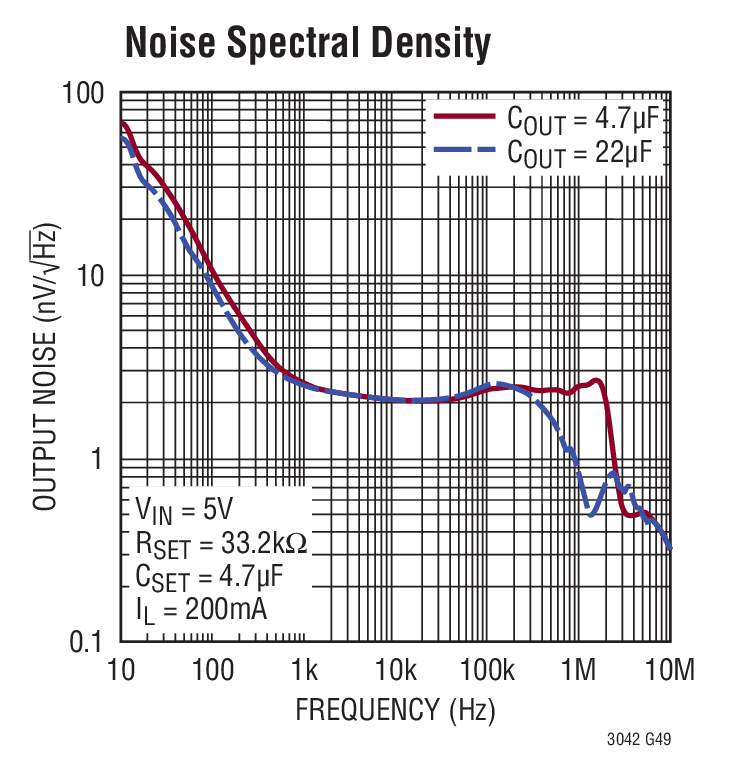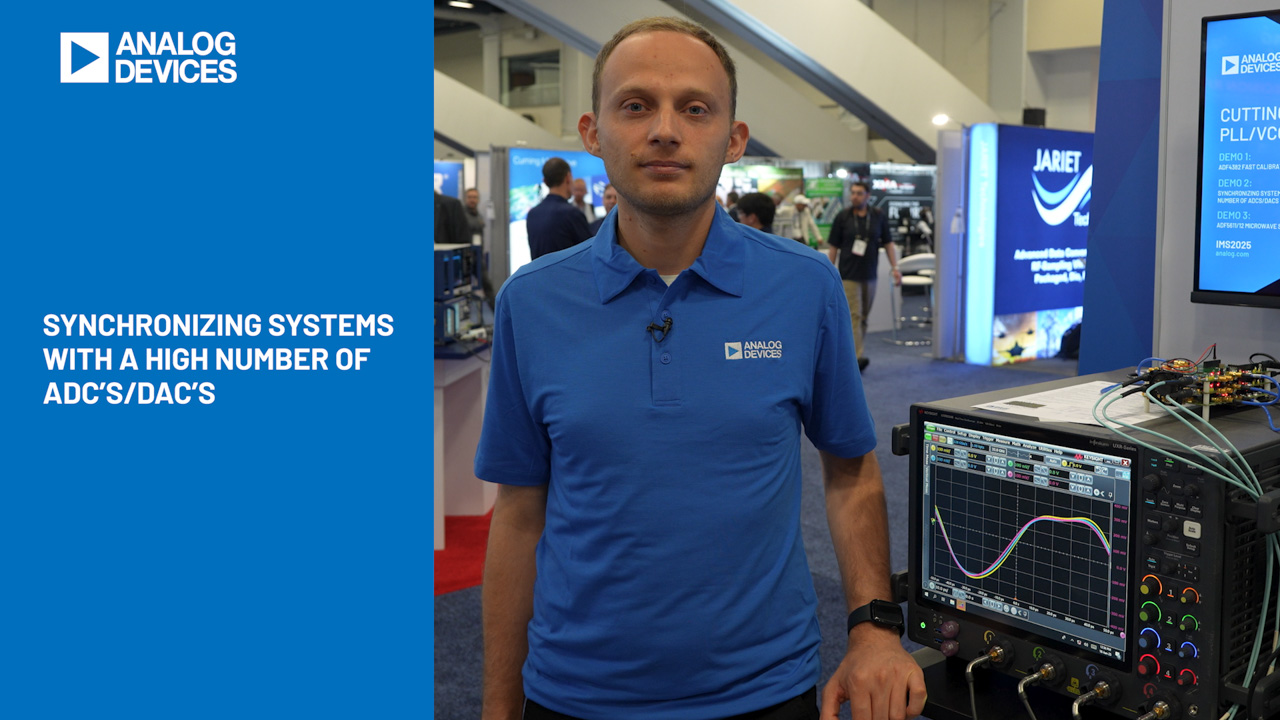Increasing Output Current of the Ultralow Noise, Ultrahigh PSRR LT3042 200mA Linear Regulator
Increasing Output Current of the Ultralow Noise, Ultrahigh PSRR LT3042 200mA Linear Regulator
Aug 17 2015
The LT0342 is a 200mA, 1.8V to 20V input, linear regulator that targets low noise RF and wireless circuits. It features an industry-leading 0.8µVRMS output noise (10Hz to 100kHz) and an impressive 79dB PSRR at 1MHz. Several customers have asked for ways to increase the current above 200mA while still maintaining low noise and high PSRR. This article examines three ways to obtain higher output current and provides practical input to help you decide which method is best for your circuit conditions. The three ways are:
- Using an external PNP transisitor
- Using an external NPN transistor
- Using multiple LT3042's in parallel
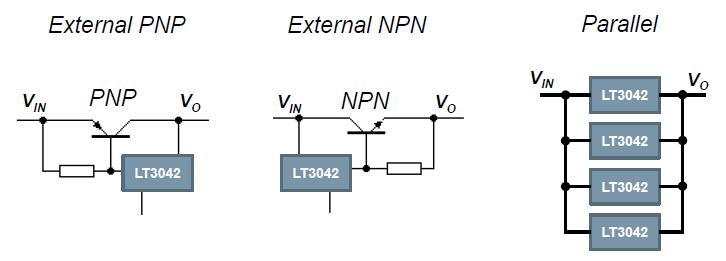
The PNP and NPN power transistors selected are the ON Semiconductor D45VH10 and D44VH10, respectively.
Linear Regulators and PSRR
Several factors determine the PSRR of a linear regulator. These include the open loop gain of the internal control loop, the bandwidth of the error amplifier, the unity gain frequency, the output current, the effective series resistance (ESR) of the output capacitor and temperature effects. Because the LT3042 already includes an internal pass transistor and has a pre-determined regulation loop, several of these parameters are already fixed. What we can do is tune the PNP and NPN circuits to optimize the circuit's performance.
The LT3042 Linear Regulator
First observe the noise spectral density vs. frequency of the LT3042. Note how increasing the CSET capacitor (the capacitor across the reference voltage) improves the lower frequency noise density and increasing the output capacitor (COUT) improves the noise density in the 300kHz to 2MHz frequency range.
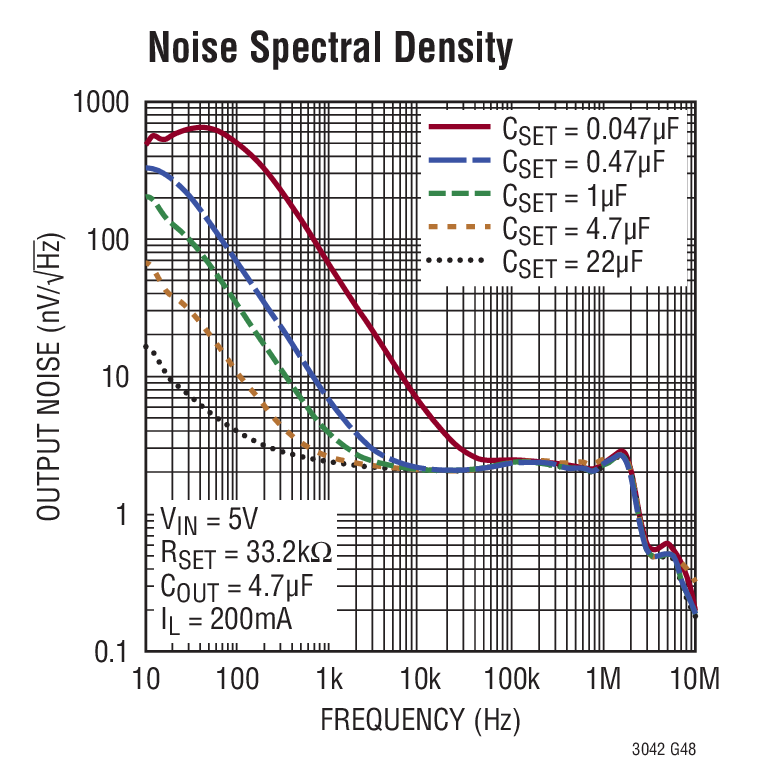
The LT3042 maintains excellent PSRR as it approaches its dropout voltage. The graph below shows PSRR as a function of the input/output differential voltage. Typical dropout is 350mV at the full 200mA load. Above a 1V input/output differential, the PSRR is greater than 70dB for frequencies ranging from 100kHz to 2MHz.
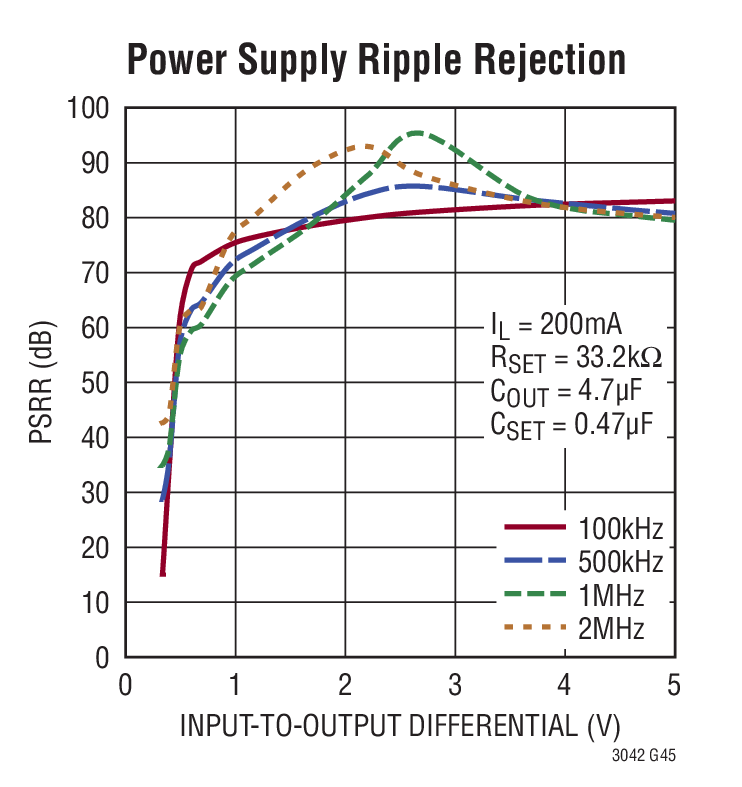
External PNP Transistor Circuit
For the PNP circuit, we can tuning the impedance network between emitter and base, and adjust the output capacitor. The 10Ω resistor between D45VH10G transistor's base and emitter limits the current from the base to the IN pin of LT3042. The higher this resistor value, the faster the transient response and higher the PSRR obtained. However, the higher this resistor, the more unstable the system becomes. Therefore we add a 22uF capacitor in series with a 0.2Ω resistance for stability. These values were obtained empirically. The higher the capacitor value, the higher the PSRR obtained. Best performance is also obtained using an output capacitor with low effective series resistance (ESR) and low effective series inductance (ESL). A 10uF capacitor was chosen.
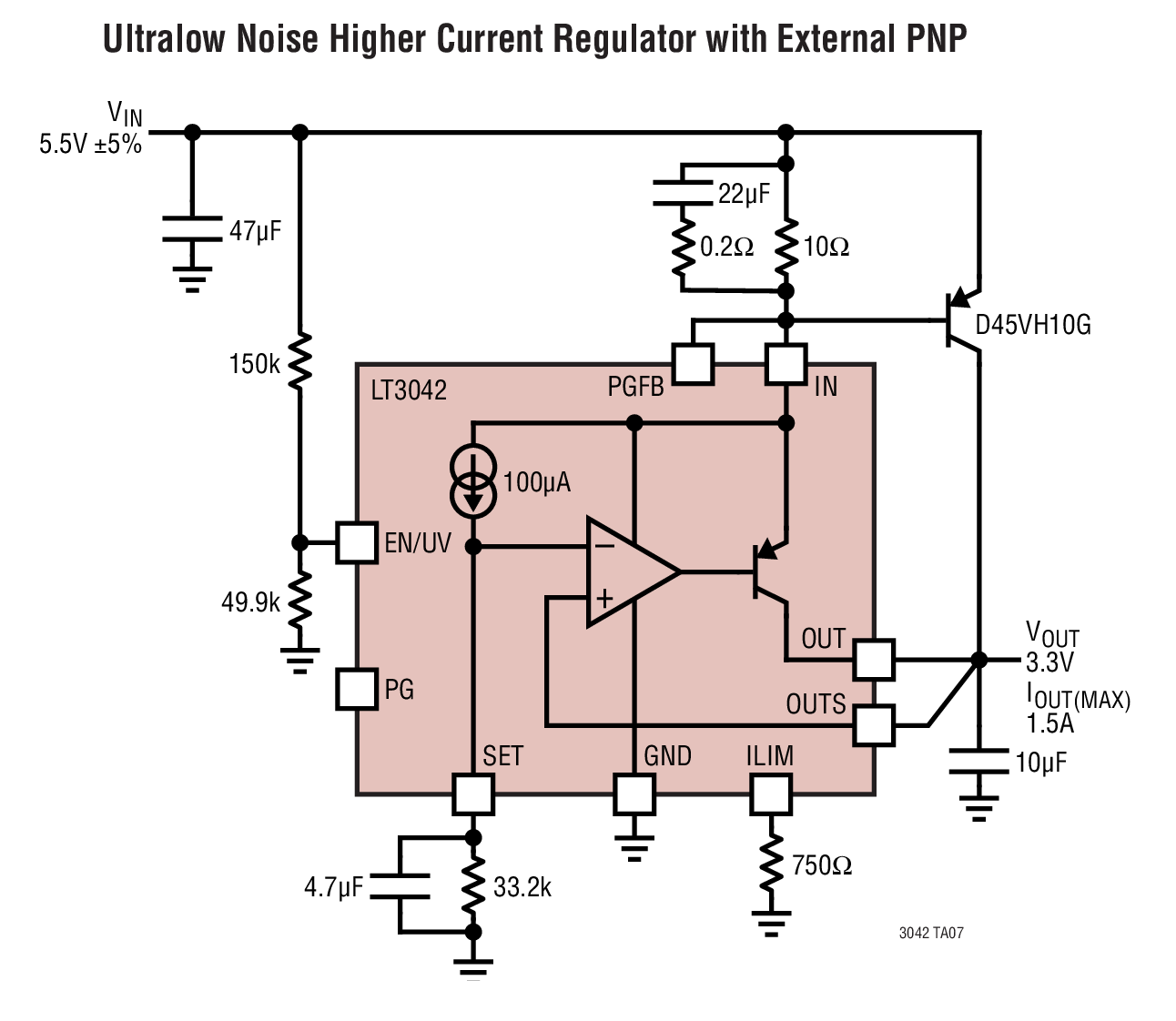
LT3042 with External PNP to Increase IOUT
The test results are shown below. The first graph is the circuit's noise spectral density plot vs. frequency at 1A, compared to the LT3042's noise spectral density plot at 0.2A. Note the external PNP circuit gives similar performance out to approximately 1MHz. At 1MHz, the two graphs diverge, with the PNP circuit showing a sharp drop in noise density, followed by a pronounced increase at higher frequencies.
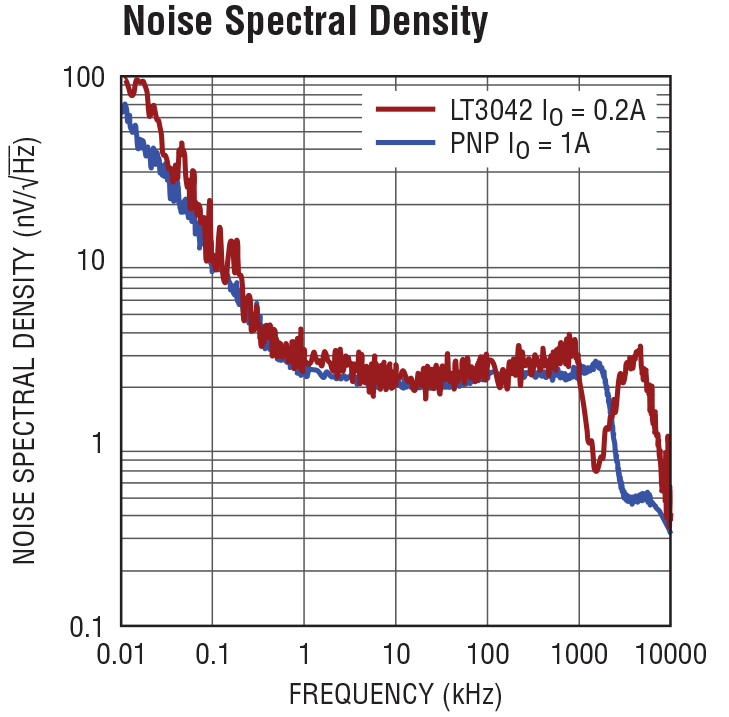
The graph below on the left shows the change in PSRR vs. frequency when implementing the external PNP solution with a 2V input/output differential. Note the PSRR is still very good (70dB PSRR means any switching noise is attenuated by approximately 3000), but the 10dB decrease in PSRR performance (compared to the LT3042 without the PNP) means the LT3042 without the PNP is 3 times better. Note how PSRR improves as the load current decreases. The graph on the right shows how the PSRR changes as the input/output voltage differential increases. Listing the results in order of highest PSRR gives 100kHz, 2MHz, 500kHz and then 1MHz.
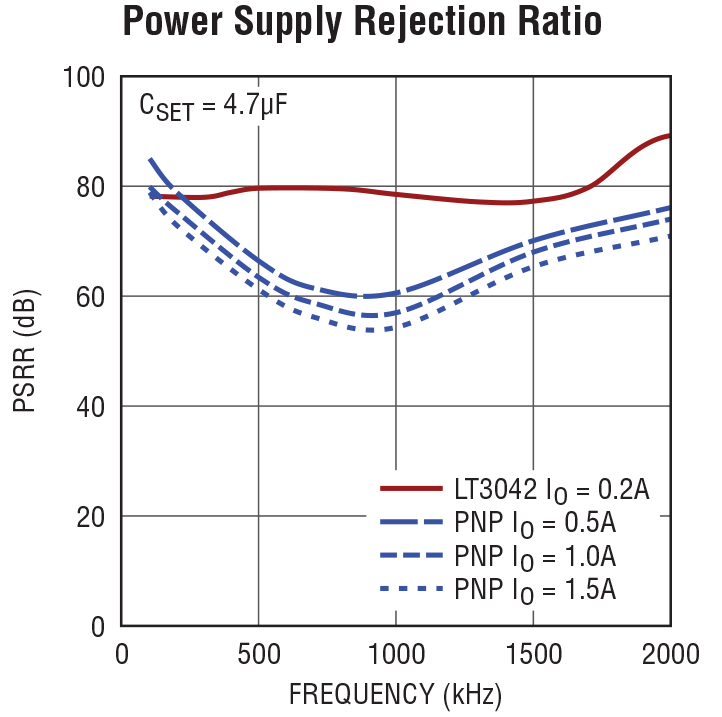
PSRR, VIN-VOUT = 2V
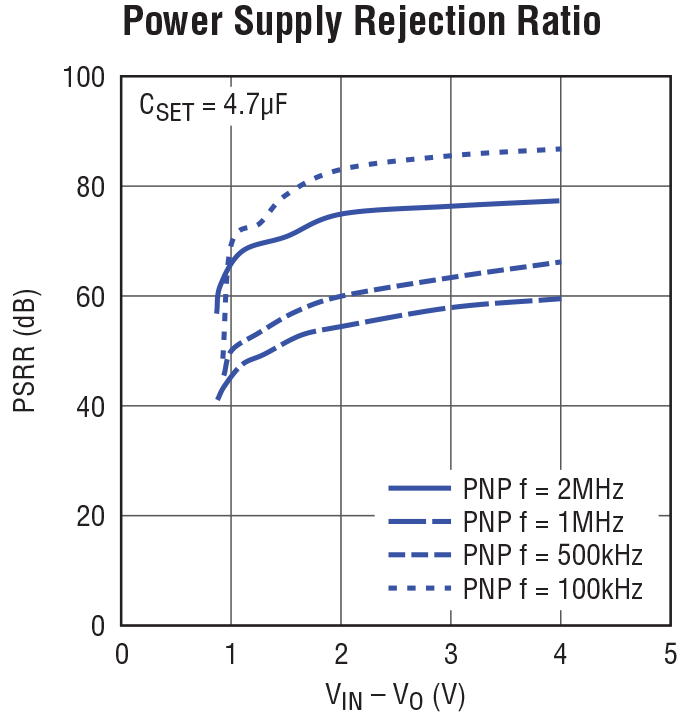
PSRR, IOUT = 1.5A
External NPN Transistor Circuit
Now let's shift the analysis to using an NPN transistor to increase output current as shown in the circuit below. Under normal operation (without an external transistor), the OUT pin connects directly to the OUTS (output voltage sense pin). However, to improve circuit stability, the impedance network between the OUT and OUTS pins is tuned. The 10kΩ resistor limits the current that flows from the base, directly to OUTS. The 10uF capacitor stabilizes the system.
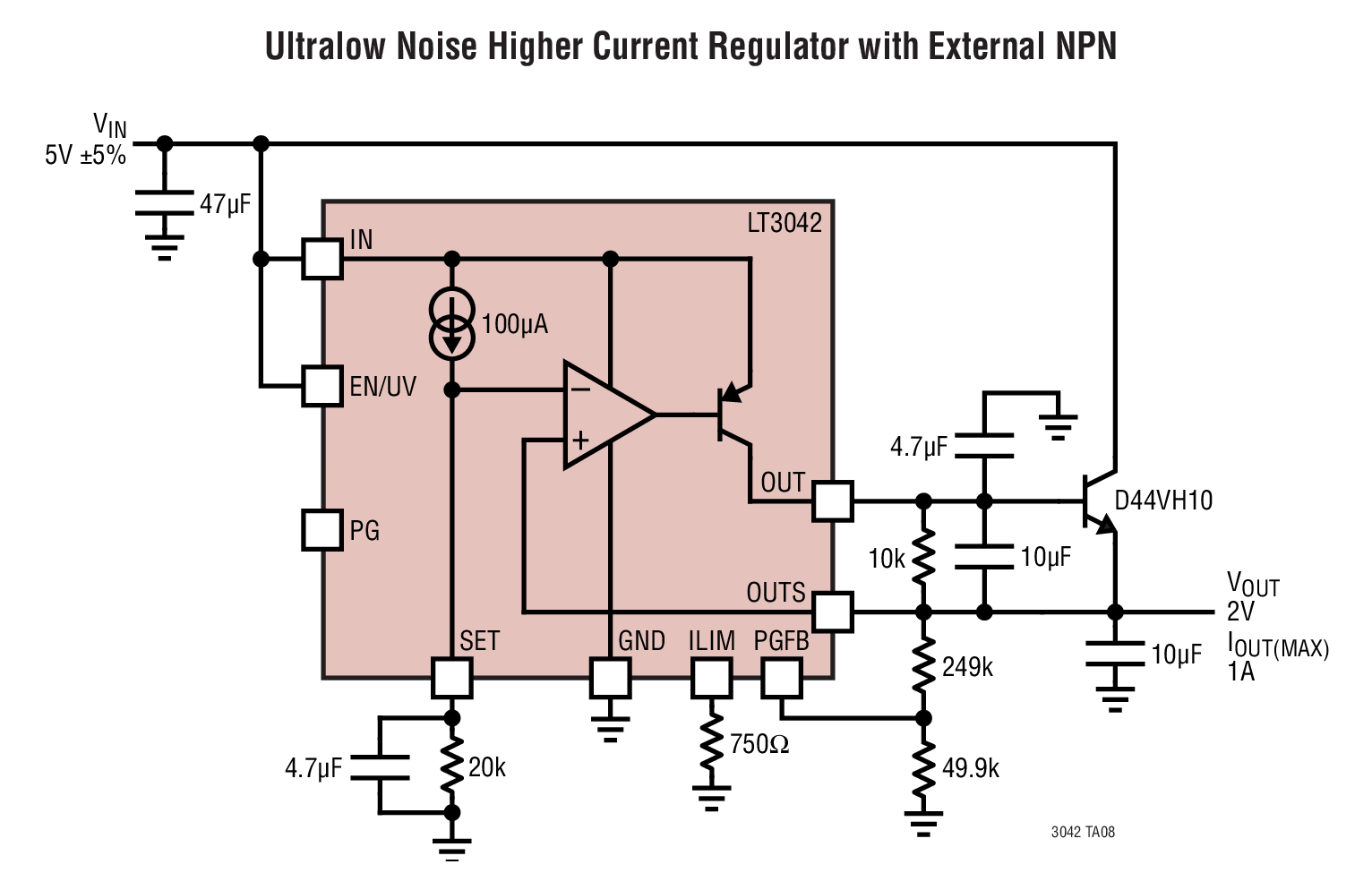
LT3042 with External NPN to Increase IOUT
The graph belows shows the difference in noise density between the 200mA LT3042 circuit and the 1A LT3042 plus NPN solution. The NPN solution has slightly higher noise density until about 100kHz, but then its noise density drops significantly. Near 3MHz, the graph plots cross.
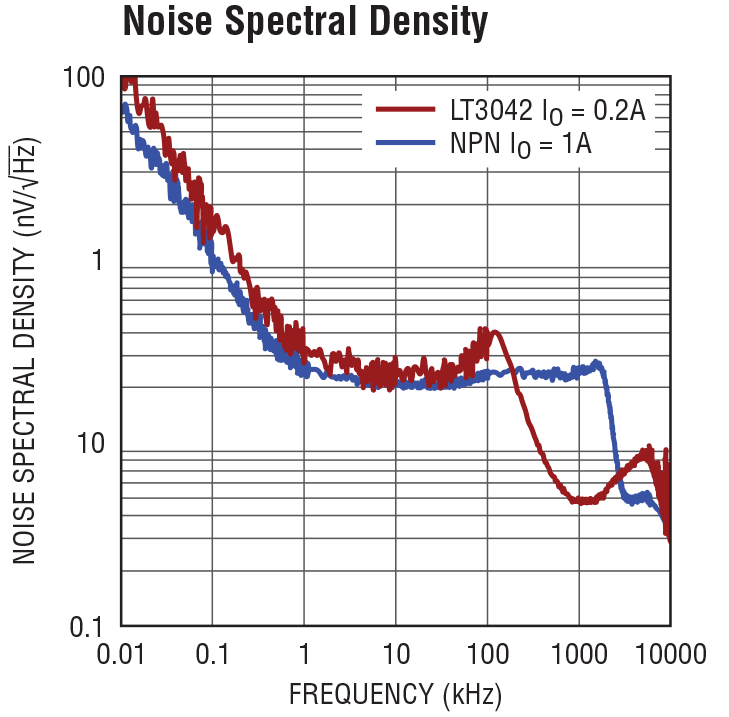
The graph below and on the left shows the change in PSRR vs. frequency for the NPN circuit using the same conditions as the PNP circuit. Comparing these results reveals a similar load current trend, namely ;PSRR increases with increasing load current. With a similar output current for both circuits (ex. 1A), the NPN circuit starts at a much lower PSRR value (60dB) and rises fairly consistently to almost 80dB as frequency increases; the PNP circuit data is bowed in shape—it starts at high PSRR (80dB), drops down to about 60dB and then rises again at higher frequencies to approximately 70dB.
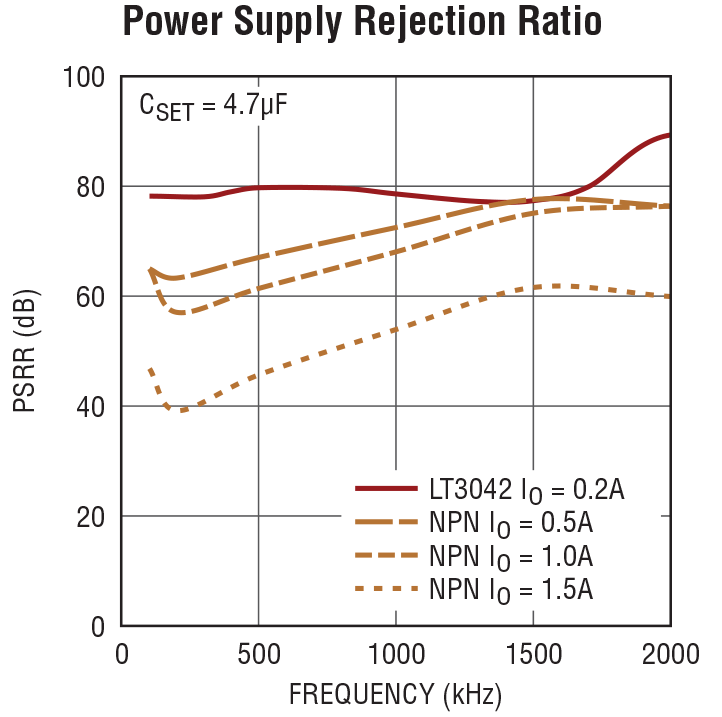
PSRR, VIN-VOUT = 2V
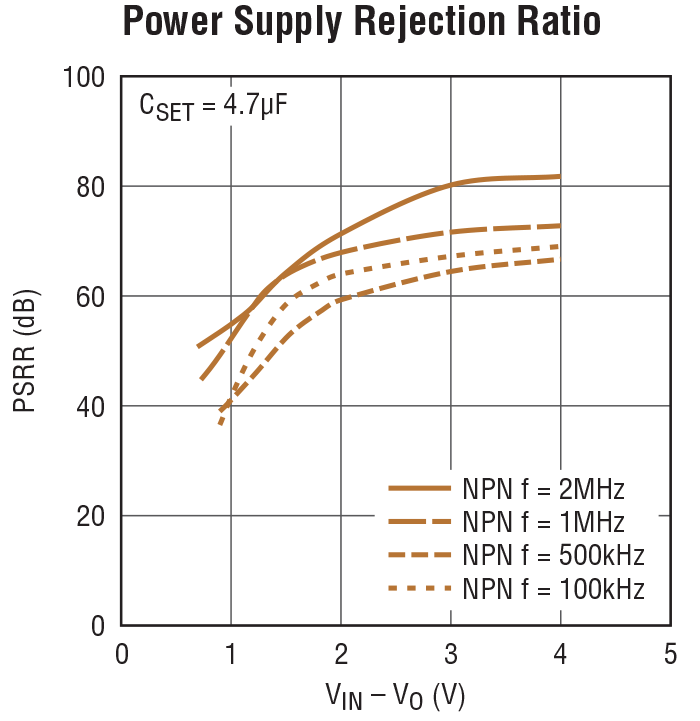
PSRR, IOUT = 1.0A
Now observe the PSRR vs. VIN-to-VOUT differential graph to the right. Even though the output current is slightly lower than the similar PNP circuit above (1A vs. 1.5A), some general observations can be made. First, the PSRR degrades as the MOSFET approaches dropout. Also, the PSRR improves by at least 20dB with the VIN-to-VOUT differential greater than 3.5V. For the NPN circuit, the ranking of the frequencies, highest to lowest with best PSRR listed first is: 2MHz, 1MHz, 100kHz and 500kHz. Note how this is different from the PNP circuit which has a frequency ranking order of 100kHz, 2MHz, 500kHz and then 1MHz.
Next observe the transient response for the PNP and NPN circuits. With a 1A load step, the NPN circuit exhibits a much longer settling time, but does have a lower peak voltage by roughly 25%. The goal of highlighting the above differences is not to give a detailed explanation as to why, but to show how different components and circuit conditions can affect the circuit's operation. Without proper understanding and evaluation, these differences can result in performance, stability and reliability issues.
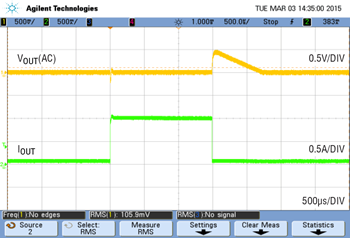
NPN Transient Response
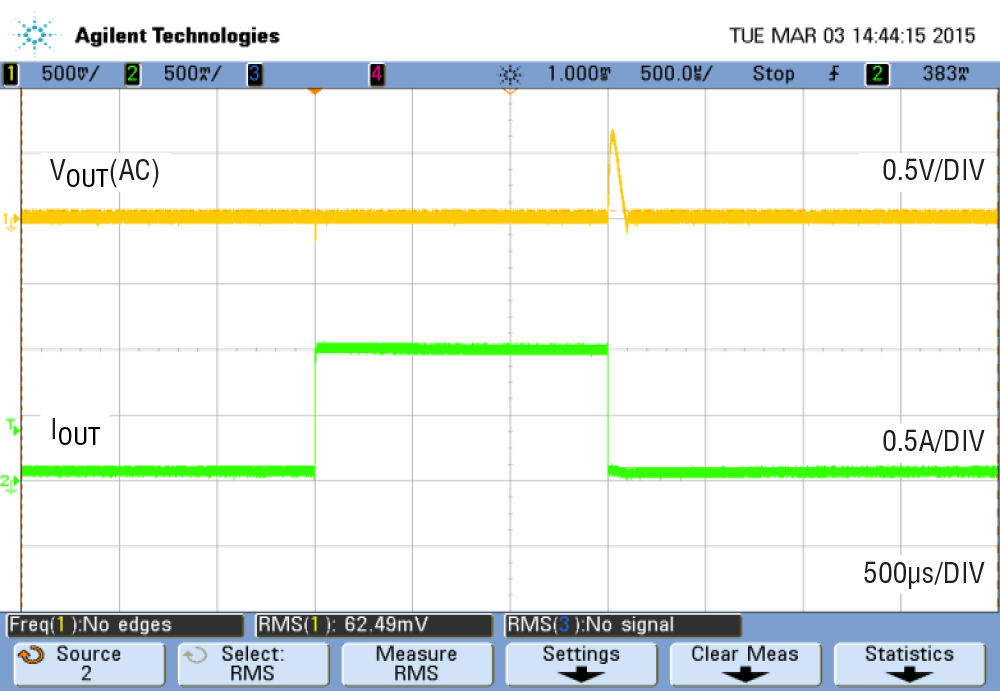
PNP Transient Response
Paralleling LT3042's
Another way to increase the output current is to parallel the outputs of multiple LT3042's. The LT3042 has a precision current source reference on-chip, which makes both paralleling the outputs and current sharing very simple. A small ballast resistor is required at each output to prevent the outputs from fighting against each other. The figure below shows four LT3042s with the outputs paralleled to obtain a 0.8A solution.

A key advantage of paralleling devices is that it reduces the output noise spectral density. For a better understanding of why this occurs, refer to the blog "Paralleling Amplifiers Improves SNR Performance" Though this blog discusses amplifier noise, the same concept can be applied to linear regulator output noise. The graph below shows the results for the LT3042, the LT3042 plus external PNP transistor, the LT3042 plus external NPN transistor, and the paralleled LT3042 circuit. As expected, the paralleled solution has the best performance.
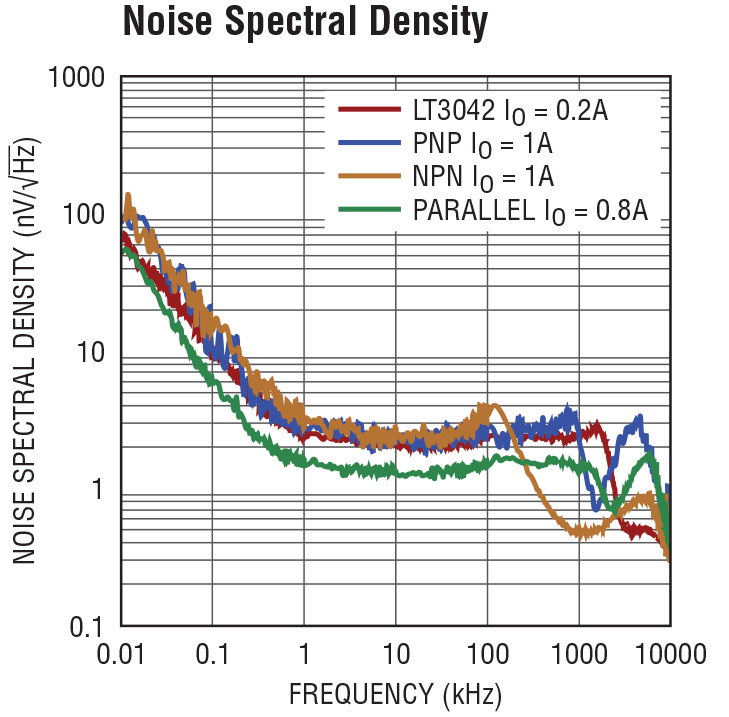
Another advantage of paralleling devices is that PSRR does not decrease; it stays relatively constant as the following graph reveals, unlike the NPN and PNP circuits. The NPN circuit data is light brown in color, the PNP data is blue, the LT3042 data is red and the paralleled LT3042 circuit data is green. The red and green lines are very similar; the paralleled circuit maintains high PSRR over frequency.
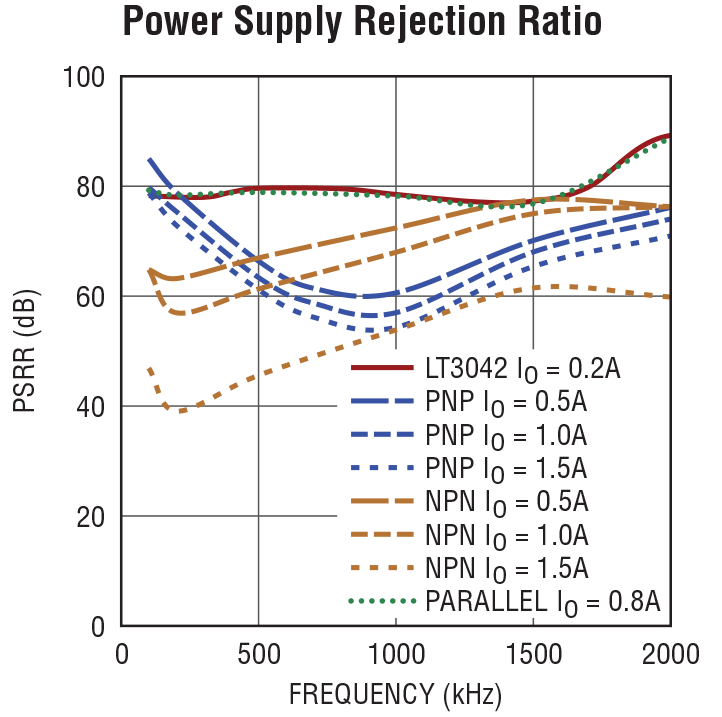
Finally, the paralleled LT3042 circuit has the best transient response, as one would expect. The added circuitry of the NPN and PNP circuits complicates the control loop and slows down the transient response. With four LT3042s in parallel (800mA), the transient response has smaller overshoot and undershoot, and settles roughly 20 times faster than the 1A PNP circuit and 100 times faster than the 1A NPN solution.
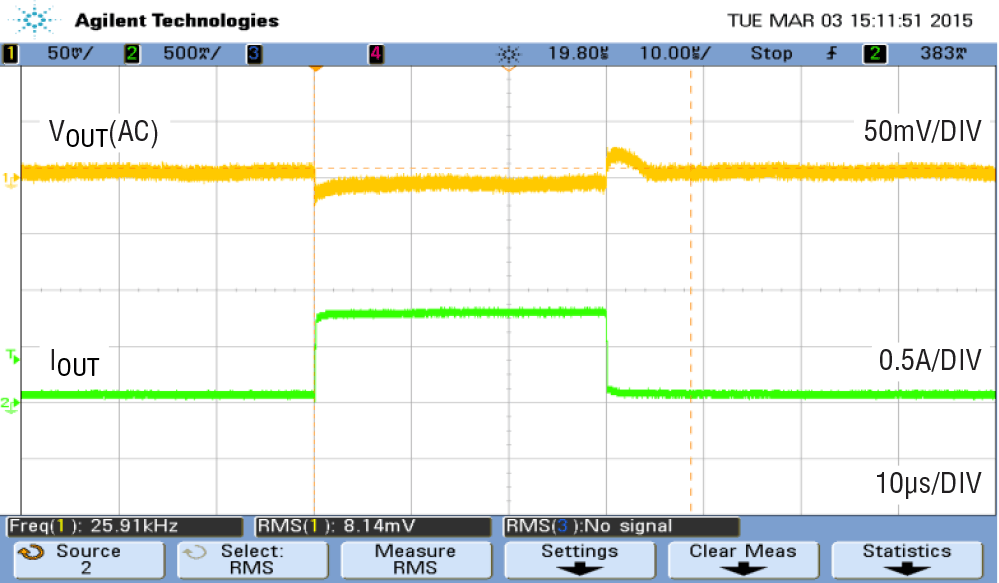
In summary, there are several ways to increase the output current of the ultralow noise, ultrahigh PSRR LT3042. From the data above, the paralleled solution yields the best PSRR, the best noise spectral density and the best transient response. If any one of these is a critical design specification then this solution is recommended. This solution also provides current limiting and thermal shutdown protection. The trade-off, however is the solution cost.
The PNP solution is more cost-effective and has better PSRR when greater than 1A of output current is needed. It has a 1.5V (approximate) dropout voltage and does not provide thermal shutdown protection.
The NPN solution also is cost-effective and has better PSRR when the output current is less than 1A. It also has a 1.5V (approximate) dropout voltage and does not provide thermal shutdown protection.
About the Authors
Kevin Scott works as a Product Marketing Manager for the Power Products Group at Analog Devices, where he manages Boost, Buck-Boost and Isolated Converters, LED Drivers and Linear Regulators. He previously worked as a Seni...
Amit Patel is a senior design manager at Analog Devices Inc. (ADI) responsible for all new LDO product development. He has been with Linear Technology/ADI for 11 years, starting as a design engineer in the Power Products g...
Dawson Huang joined Linear Technology Corporation in 2014 as an applications engineer. His work includes development, evaluation and characterization of new power management ICs. He is also in charge of circuit design and ...
